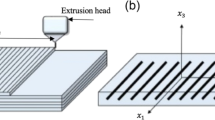Abstract
Developable surfaces are desired in designing products manufactured from planar sheets. Trimmed non-uniform rational B-spline (NURBS) surface patches are widely adopted to represent 3D products in CAD/CAM. This paper presents a new method to increase the developability of an arbitrarily trimmed NURBS surface patch. With this tool, designers can first create and modify the shape of a product without thinking about the developable constraint. When the design is finished, our approach is applied to increase the developability of the designed surface patches. Our method is an optimisation-based approach. After defining a function to identify the developability of a surface patch, the objective function for increasing the developability is derived. During the optimisation, the positions and weights of the free control points are adjusted. When increasing the developability of a given surface patch, its deformation is also minimised and the singular points are avoided. G0 continuity is reserved on the boundary curves during the optimisetion, and the method to reserve G1 continuity across the boundaries is also discussed in this paper. Compared to other existing methods, our approach solves the problem in a novel way that is close to the design convention, and we are dealing with the developability problem of an arbitrarily trimmed NURBS patch.








Similar content being viewed by others
References
Mortenson ME (1997) Geometric modeling 2nd ed. Wiley, New York
Chalfant JS, Maekawa T (1998) Design for manufacturing using B-spline developable surfaces. J Ship Res 42(3):207–215
Azariadis PN, Aspragathos NA (2001) Geodesic curvature preservation in surface flattening through constrained global optimization. Comp Aided Des 33(8):581–591
McCartney J, Hinds BK, Seow BL (1999) The flattening of triangulated surfaces incorporating darts and gussets, Comp Aided Des 31(4):249–260
Wang CCL, Smith SSF, Yuen MMF (2002) Surface flattening based on energy model. Comp Aided Des 34(11):823–833
Maekawa T, Chalfant J (1998) Design and tessellation of B-spline developable surfaces. ASME Trans J Mech Des 120:453–461
Aumann G (1991) Interpolation with developable Bézier patches. Comp Aided Geom Des 8:409–420
Frey WH, Bindschadler D (1993) Computer aided design of a class of developable Bézier surfaces. GM Res Publ 1993, GMR-8057
Chu CH, Séquin CH (2002) Developable Bézier patches: properties and design. Comp Aided Des 34(7):511–527
Hoschek J, Pottmann H (1995) Interpolation and approximation with developable B-spline surfaces. Mathematical methods. In: Daehlen M, Lyche T, Schumaker L (eds) CAGD III, Vanderbilt University Press, Nashville, TN
Chen HY, Lee IK, Leopoldseder S, Pottmann H, Randrup T, Wallner J (1999) On surface approximation using developable surfaces. Graph Mod Imag Process 61(2):110–124
Pottmann H, Wallner J (1999) Approximation algorithms for developable surfaces. Comp Aid Geom Des 16(6):539–556
Redont P (1989) Representation and deformation of developable surfaces. Comp Aided Des 21(1):3–20
Randrup T (1998) Approximation of surfaces by cylinders. Comp Aided Des 30(10):807–812
Park FC, Yu J, Chun C (2002) Design of developable surfaces using optimal control. ASME Trans J Mech Des 124:602–608
Piegl L, Tiller W (1997) The NURBS Book 2nd ed. Springer, Berlin Heidelberg New York
Do Carmo MP (1976) Differential geometry of curves and surfaces. Prentice Hall, Englewood Cliffs, NJ
Chan TF, Vese LA (2001) Active contours without edges. IEEE Trans Image Processing 10:266–277
Peiró J (1999) Surface grid generation. In: Thompson JF, Soni BK, Weatherill NP (eds) Handbook of grid generation. CRC Press, Boca Raton, FL
Lewis PE, Ward JP (1991) The finite element method: principles and applications. Addison-Wesley, Reading, MA
Conte SD, De Boor C (1980) Elementary numerical analysis: an algorithm approach. McGraw-Hill, New York
Vanderplaats GN (1984) Numerical optimization techniques for engineering design: with applications. McGraw-Hill, New York
Author information
Authors and Affiliations
Corresponding author
Rights and permissions
About this article
Cite this article
Wang, C.C.L., Wang, Y. & Yuen, M.M.F. On increasing the developability of a trimmed NURBS surface. Engineering with Computers 20, 54–64 (2004). https://doi.org/10.1007/s00366-004-0272-8
Received:
Accepted:
Published:
Issue Date:
DOI: https://doi.org/10.1007/s00366-004-0272-8




